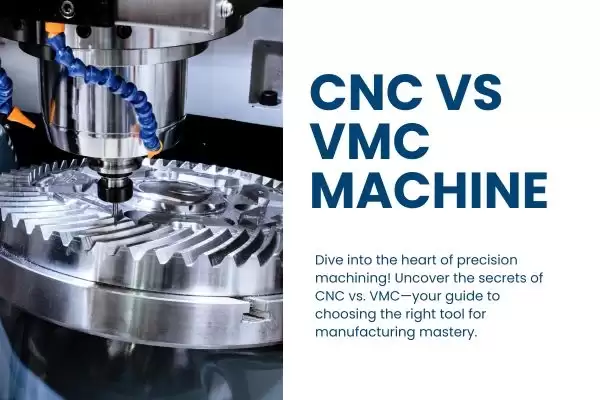
Aug 13,2024
In the intricate world of precision machining, CNC (Computer Numerical Control) and VMC (Vertical Machining Center) are two terms that often pop up. To the uninitiated, these acronyms might seem like interchangeable jargon, but they represent distinct technologies with unique applications and functionalities. In this exploration, we'll delve into the differences between CNC and VMC, shedding light on the nuances that make each indispensable in modern manufacturing.
In the vast landscape of manufacturing, precision is paramount. CNC and VMC are stalwarts in pursuing accuracy, efficiency, and repeatability. CNC, the older of the two technologies, is the foundation for many machining processes. It operates on numerical control, allowing for the automated control of machining tools and 3D printers using a computer. Its evolution paved the way for the emergence of VMC, a more specialized form of machinery that operates in a vertical orientation.
At its core, CNC relies on computerized control to navigate the intricate dance of machining tools. Historically, this technology has evolved remarkably, transitioning from punch cards to advanced computer systems. The heart of CNC lies in its ability to interpret design specifications and translate them into precise movements of cutting tools. This versatility has made CNC a cornerstone in various manufacturing processes, from metal to woodworking.
Vertical Machining Center (VMC), on the other hand, represents a more refined and specialized iteration of CNC. As the name suggests, VMC operates with the spindle vertically, distinguishing it from its horizontal counterpart. This seemingly subtle difference holds profound implications for the tasks in which VMC excels. With its vertical orientation, VMC is particularly adept at plunging and drilling tasks.
When we pit CNC against VMC, a nuanced comparison emerges. As a broader category, CNC encompasses a range of machining processes, including milling, turning, and electrical discharge machining. While a subset of CNC, VMC specializes in vertical milling, offering distinct advantages in certain applications. Precision and accuracy, crucial in any manufacturing setting, are attributes where both technologies shine, but the devil is in the details.
A table-based comparison reveals the strengths and weaknesses of each. CNC's versatility allows it to handle a broader spectrum of tasks, but VMC's specialization makes it a powerhouse in vertical milling scenarios. The choice between the two depends on the specific needs of the project and the intricacies of the materials being worked on.
To truly understand the differences between CNC and VMC, examining their real-world applications is essential. CNC is home in the aerospace, automotive, and electronics industries, where various machining processes are employed. Conversely, VMC takes the stage in precision vertical machining applications, making it indispensable in industries that demand intricate detailing, such as mold and die-casting.
Real-world examples highlight the practical implications of choosing one technology over the other. In a scenario where precision is non-negotiable, VMC emerges as the hero. However, when versatility and adaptability are paramount, CNC proves its worth across a broader range of applications.
Understanding the advantages and limitations of CNC and VMC is crucial for making informed decisions. CNC's flexibility and adaptability are unparalleled, allowing manufacturers to seamlessly switch between machining processes. With its vertical orientation, VMC excels in tasks involving plunging and drilling, offering a higher degree of precision in these specific operations.
However, it's essential to acknowledge the limitations of each technology. CNC's versatility comes at the cost of specialization, while VMC's precision in vertical milling may not be as pronounced in other machining processes. Overcoming these limitations involves strategic planning, where the right tool is selected for the right job.
Choosing between CNC and VMC requires a thoughtful analysis of various factors. Budget considerations, long-term investment goals, and the nature of the industry all play a role in this decision-making process. Industry trends and future developments also come into play, as staying abreast of technological advancements ensures that your manufacturing processes remain competitive.
Expert insights and recommendations can guide decision-makers through this maze of choices. Engaging with professionals in the field, attending industry events, and staying connected with the latest research can provide valuable perspectives. Making an informed decision involves a holistic approach that balances immediate needs with long-term goals.
CNC and VMC represent threads of innovation and technological prowess in the grand tapestry of precision machining. At the same time, CNC lays the foundation with its broad applicability, and VMC hones in on vertical machining with unparalleled precision. The choice between the two depends on the canvas you're painting and the masterpiece you aim to create.
As we conclude this exploration, it's clear that both CNC and VMC have integral roles in modern manufacturing. Each technology brings its own set of advantages and limitations to the table. It's not a matter of one being superior to the other but rather a question of which tool best suits the task. In the dynamic world of machining, understanding these subtleties is the key to unlocking the full potential of your manufacturing processes.